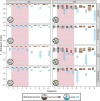Varying Responses to Heat Stress and Salinization Between Benthic and Pelagic Riverine Microbial Communities
- PMID: 40908508
- PMCID: PMC12411665
- DOI: 10.1111/1462-2920.70173
Varying Responses to Heat Stress and Salinization Between Benthic and Pelagic Riverine Microbial Communities
Abstract
Microbial communities play a crucial role in the functioning of freshwater ecosystems but are continuously threatened by climate change and anthropogenic activities. Elevated temperatures and salinisation are particularly challenging for freshwater habitats, but little is known about how microbial communities respond to the simultaneous exposure to these stressors. Here, we use mesocosm experiments and amplicon sequencing data to investigate the responses of pelagic and benthic microbial communities to temperature and salinity increases, both individually and in combination. Our results highlight the varying responses of freshwater microbial communities, with sediment communities exhibiting greater stability in response to environmental changes compared to water column communities, and salinisation having a more pronounced impact on microeukaryotes compared to prokaryotes. Simultaneous exposure to elevated temperature and salinity reduced the impact of salinisation on prokaryotes, while microeukaryotes were similarly affected by the combined treatments and salinisation alone. These findings emphasise the complexity of microbial responses to single and multiple stressors, underscoring the need to consider both individual and interactive effects when predicting ecosystem responses to environmental changes.
Keywords: anthropogenic stressors; climate change; freshwater; heatwaves; mesocosm experiment; microbial communities; salinization.
© 2025 The Author(s). Environmental Microbiology published by John Wiley & Sons Ltd.
Conflict of interest statement
The authors declare no conflicts of interest.
Figures




References
-
- Amaral‐Zettler, L. A. , McCliment E. A., Ducklow H. W., and Huse S. M.. 2009. “A Method for Studying Protistan Diversity Using Massively Parallel Sequencing of V9 Hypervariable Regions of Small‐Subunit Ribosomal RNA Genes.” PLoS One 4, no. 7: e6372. 10.1371/journal.pone.0006372. - DOI - PMC - PubMed
-
- Astorg, L. , Gagnon J.‐C., Lazar C. S., and Derry A. M.. 2022. “Effects of Freshwater Salinization on a Salt‐naïve Planktonic Eukaryote Community.” Limnology and Oceanography Letters 8: 38–47. 10.1002/lol2.10229. - DOI
-
- Barnett, D. J. , Arts I. C., and Penders J.. 2021. “microViz: An R Package for Microbiome Data Visualization and Statistics.” Journal of Open Source Software 6, no. 63: 3201. 10.21105/joss.03201. - DOI
MeSH terms
Grants and funding
LinkOut - more resources
Full Text Sources

